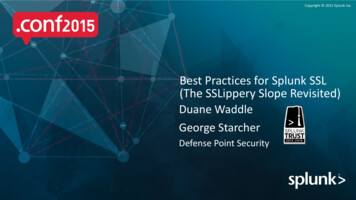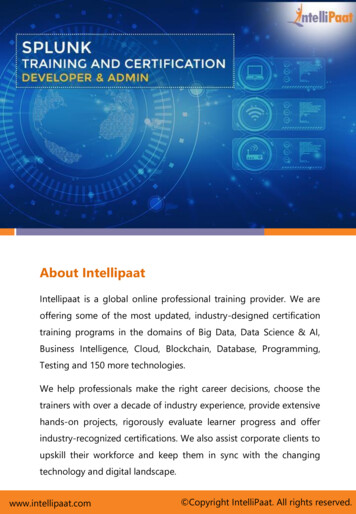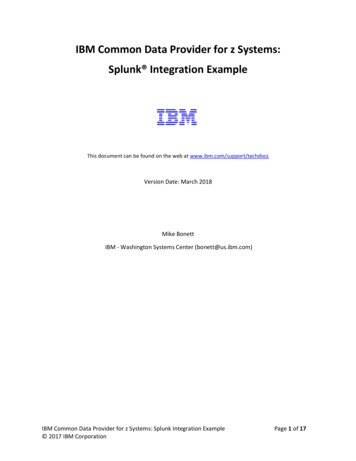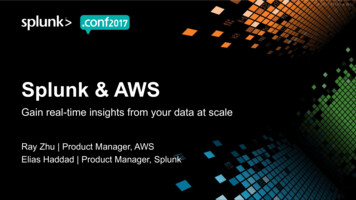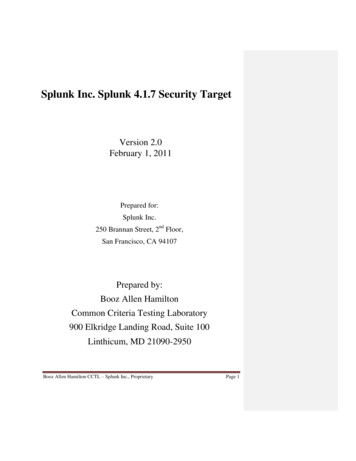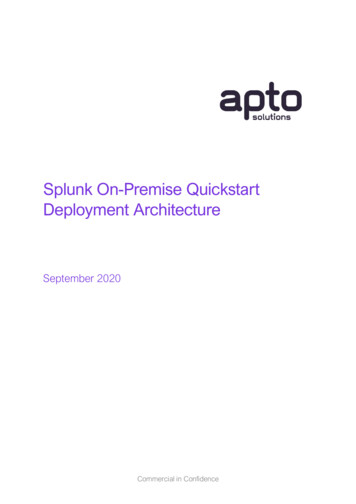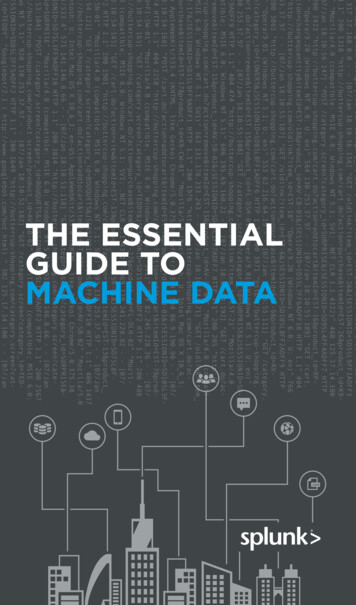
Transcription
p-shopping.com/category.screen?category id GIFTS” “Mozilla/4.0 (compatible; MSIE 6.0; Windows NT317 27.160.0.0 - - [07/Jan 18:10:56:156] “GET /oldlink?item id EST-26&JSESSIONID SD5SL9FF1ADFF31.1” 200 1318 “http://buttercup-shopping.com/cart.do?action purchase&itemId EST-26&product id K9” “Mozilla/4.0 (compatible; MSIE 6.0; Windows NT 5.1; SV1; .NET CLR 1.1.4322)” 468 125.17.14.10007/Jan 18:10:56:147] “POST /category.screen?category id SURPRISE&JSESSIONID SD9SL4FF4ADFF7 HTTP200 2423 “http://buttercup-shopping.com/cart.do?action addtocart&itemId EST-16&product id RP” “Opera/9.20 (Windows NT 6.0; U; en)” 564 130.253.37.97 - - [07/Jan 18:10:55:189] “GET /cart.tion changequantity&itemId EST-18&product id AV-CB-01&JSESSIONID SD5SL7FF6ADFF10 HTTP 1.1” 404“http://buttercup-shopping.com/oldlink?item id EST-18” “Opera/9.20 (Windows NT 6.0; U; en)” 76653.37.97 - - [07/Jan 18:10:55:187] “GET /oldlink?item id EST-6&JSESSIONID SD10SL8FF2ADFF9 HTTP200 3865 “http://buttercup-shopping.com/cart.do?action purchase&itemId EST-6&product id AV” “Opera/9.01 (Windows NT 5.1; U; en)” 553 62.216.64.19 - - [07/Jan 18:10:55:111] “GET /category.n?category id FLOWERS&JSESSIONID SD8SL8FF1ADFF6 HTTP 1.1” 200 3971 “http://buttercup-shopping.art.do?action remove&itemId EST-15&product id FL-DSH-01” “Opera/9.01 (Windows NT 5.1; U; en)”30.253.37.97 - - [07/Jan 18:10:55:108] “GET /category.screen?category id SURPRISE&JSESSIONID SDF9ADFF9 HTTP 1.1” 404 474 “http://buttercup-shopping.com/oldlink?item id EST-21” “Mozilla/4.0atible; MSIE 6.0; Windows NT 5.1)” 606 195.69.160.22 - - [07/Jan 18:10:54:192] “GET /cart.do?acremove&itemId EST-15&product id AV-SB-02&JSESSIONID SD4SL1FF7ADFF7 HTTP 1.1” 200 205 “http://rcup-shopping.com/cart.do?action remove&itemId EST-15&product id AV-SB-02” “Mozilla/4.0 (compatiMSIE 6.0; Windows NT 5.1; SV1)” 163 131.178.233.243 - - [07/Jan 18:10:54:171] “GET /oldlink?itemT-17&JSESSIONID SD1SL9FF9ADFF1 HTTP 1.1” 200 1976 e&itemId EST-17&product id K9-CW-01” “Mozilla/5.0 (Macintosh; U; Intel Mac OS X 10 6 3;) AppleWebKit/533.4 (KHTML, like Gecko) Chrome/5.0.375.38 Safari/533.4” 544 86.9.190.90 - - [07/8:10:54:166] “POST /cart.do?action addtocart&itemId EST-7&product id FI-SW-01&JSESSIONID SD10SL3FF4 HTTP 1.1” 404 2258 “http://buttercup-shopping.com/cart.do?action addtocart&itemId EST-7&prodd FI-SW-01” “Mozilla/4.0 (compatible; MSIE 6.0; Windows NT 5.1; SV1)” 189 82.245.228.36 - - [07/8:10:54:165] “GET /category.screen?category id TEDDY&JSESSIONID SD1SL1FF8ADFF2 HTTP 1.1” 200 488://buttercup-shopping.com/cart.do?action purchase&itemId EST-27&product id FL-DLH-02” “Mozil0 (compatible; MSIE 6.0; Windows NT 5.1; SV1; .NET CLR 1.1.4322)” 969 128.241.220.82 - - [07/8:10:54:145] “GET /cart.do?action view&itemId EST-13&product id RP-SN-01&JSESSIONID SD7SL8FF2 HTTP 1.1” 200 1901 “http://buttercup-shopping.com/cart.do?action view&itemId EST-13&product-SN-01” “Mozilla/4.0 (compatible; MSIE 6.0; Windows NT 5.1; SV1)” 393 130.253.37.97 - - [07/Jan:54:121] “GET /category.screen?category id BOUQUETS&JSESSIONID SD10SL1FF4ADFF10 HTTP 1.1” 406 1437://buttercup-shopping.com/cart.do?action addtocart&itemId EST-27&product id AV-SB-02” “Mozilla/5.0ntosh; U; Intel Mac OS X 10 6 3; en-US) AppleWebKit/533.4 (KHTML, like Gecko) Chrome/5.0.375.38i/533.4” 571 141.146.8.66 - - [07/Jan 18:10:53:118] “GET /category.screen?category id SURPRISE&IONID SD7SL3FF9ADFF10 HTTP 1.1” 200 3814 ateid SURPRISE” “Mozilla/4.0 (compatible; MSIE 6.0; Windows NT 5.1)” 932 141.146.8.66 - - [07/Jan:53:104] “POST /category.screen?category id BOUQUETS&JSESSIONID SD3SL1FF7ADFF2 HTTP 1.1” 200 ct id AV-SB-02” “Mozilla/4.0 (compatible; MSIE 6.0;ws NT 5.1)” 920 130.253.37.97 - - [07/Jan 18:10:52:182] “GET /category.screen?category id TEDESSIONID SD8SL2FF5ADFF2 HTTP 1.1” 200 1649 at id TEDDY” “Googlebot/2.1 ( http://www.googlebot.com/bot.html) “ 302 125.17.14.100 - - [07/JanTHE ESSENTIALGUIDE TOMACHINE DATA
DIGITAL EXHAUST.TIME-SERIES DATA.BIG DATA.Whatever you call it, machine data is one of themost underused and undervalued assets of anyorganization. And, unfortunately, it’s usually keptfor some minimum amount of time before beingtossed out and never looked at again.2But some of the most important insights you can gain—acrossIT and the business—are hidden in this data: where things wentwrong, how to optimize the customer experience, the fingerprintsof fraud. All of these insights can be found in the machine datagenerated by the normal operations of your organization.Machine data is valuable because it contains a definitive record ofall the activity and behavior of your customers, users, transactions,applications, servers, networks and mobile devices. It includesconfigurations, data from APIs, message queues, change events,the output of diagnostic commands, call detail records and sensordata from industrial systems and more.The challenge with leveraging machine data is that it comes in adizzying array of unpredictable formats, and traditional monitoringand analysis tools weren’t designed for the variety, velocity,volume or variability of this data. But there’s a tremendous upsidefor organizations that take advantage of this data—includingquickly diagnosing service problems, detecting sophisticatedsecurity threats, understanding the health and performance ofremote equipment and demonstrating compliance.3
USING MACHINE DATAIN PRACTICESOURCESMACHINE DATAOrderProcessingMiddlewareErrorUsing machine data requires three(seemingly) simple steps:Care IVRTwitter1INGEST2CORRELATE3ANALYZEFigure 1: Machine data can come from any number of sources, and at firstglance, can look like random text.SOURCESThe organizations that get the most value from machine dataare able to take disparate data types, link them together, andgain value from the result. But one of the biggest challenges isunderstanding what data you should ingest.MACHINE DATACUSTOMER IDOrderProcessingMiddlewareErrorORDER IDORDER IDPRODUCT IDCUSTOMER IDON HOLD TIMECare IVRCUSTOMER IDBy defining the use cases you’re attempting to resolve – be itsecurity, IT operations, business analytics or the Internet ofThings – you can start to identify the data sources you shouldingest and begin correlating.TWITTER IDCUSTOMER TWEETTwitterCOMPANY TWITTER IDFigure 2: The value of machine data is hidden in this text.So how does machine data provide value? See the example tothe right.In this example, analyzing the machine data makes the story clear:SOURCESMACHINE DATACUSTOMER IDOrderProcessingMiddlewareErrorORDER IDORDER IDPRODUCT IDCUSTOMER ID1. A customer’s order didn’t go throughON HOLD TIME2. The customer called Support to try to resolve the issue3. After some time on hold, the customer sent a negative tweetabout the companyCare IVRCUSTOMER IDTWITTER IDCUSTOMER TWEETTwitterCOMPANY TWITTER IDBy linking together the machine data, the company can see theoriginal issue and get a full view of the customer experience.Figure 3: By correlating different types of machine data together, you can startto gain real insight into what’s going on in your infrastructure, see securitythreats or even use the insights to drive better business decisions.45
Table of ContentsTHE ESSENTIAL GUIDETO MACHINE DATAThis book provides a high-level overview of the most commontypes of machine data that are found in organizations of nearlyany size. While each organization’s needs and data sources willvary by vendor, product and infrastructure, this book details whereyou should look for machine data and the value it can provide toIT, security, business analytics and Internet of Things use cases.User Data. 8Proxies. 72Authentication. 8VoIP. 74Virtual Private Networks (VPN).10Application Data. 12System Logs. 76Antivirus. 12System Performance. 78(APM) Tool Logs.14Custom Application Logs.16& Debug LogsCRM, ERP and Other. 18Business ApplicationsCode Management.20Many of the data sources listed in this book can support multipleuse cases – this is a major part of what drives machine data’stremendous value. The use cases supported by each data sourcecan be easily identified with the icons below.Vulnerability Scanning. 22Amazon Web Services (AWS).80Microsoft Azure. 82VMware Server Logs,.84Configuration Data andPerformance MetricsPhysical InfrastructureTest Coverage Tools.26& IoT Data. 86Automation, Configuration and. 28Deployment Tools (Platforms)Physical Card Readers.86Build Systems (Platforms).30Server Logs. 90Binary Repositories. 32Backup. 92Container Logs & Metrics.34Storage.94Middleware.36Web Server.38IT OPS, APP DELIVERY& DEVOPSVirtual Infrastructure Data. 80Mail Server.24Middleware Data. 36SECURITY& COMPLIANCEOperating System Data.76Application Server.42Mobile Device Data.44Sensor Data.88Mainframe.96Patch Logs.98Telephony.100Point of Sale Systems. 102RFID/NFC/BLE.104Smart Meters. 106Network Data. 46Transportation. 108SNMP.46Medical Devices. 110Deep Packet Inspection Data.48Environmental Sensors.112DHCP.50Industrial Control Systems. 114Endpoint. 52Wearables. 116Firewall.54FTP.56Intrusion Detection/Prevention.58INTERNETOF THINGSBUSINESSANALYTICSLoad Balancer. 60DNS.62Network Access Control (NAC).64Network Switches.66Network Routers.68Additional Data Sources.118Database.118Third-Party Lists. 120Social Media Feeds.122Human Resources. 124Business Service Transaction &. 126Business Service Performance DataNetwork Protocols.7067
USER DATAAUTHENTICATIONDATAUse Cases: Security & Compliance, IT Operations, Application DeliveryExamples: Active Directory, LDAP, Identity Management,Single-Sign OnAuthentication data provides insight into users and identityactivity. Common authentication data sources include: Active Directory: a distributed directory in which organizations define user and group identities, security policies andcontent controls. LDAP: an open standard defined by the IETF and is typicallyused to provide user authentication (name and password).It has a flexible directory structure that can be used for avariety of information such as full name, phone numbers,email and physical addresses, organizational units, workgroupand manager. Identity Management: identity management is the methodof linking the users of digital resources—whether people, IoTdevices, systems or applications—to a verifiable online ID. Single Sign-On (SSO): a process of using federated identitymanagement to provide verifiable, attestable identities from asingle source to multiple systems. SSO significantly increasessecurity by tying user credentials to a single source, allowingchanges to user rights and account status to be made once,Use Cases:IT Ops & Application Delivery: Authentication data supportsIT operations teams as they troubleshoot issues related toauthentication. For example, application support can be tied tologins, enabling IT operations to see whether users are strugglingto log in to applications. For IT operations teams that supportActive Directory, logs can be used to troubleshoot and understandthe health of Active Directory.Security & Compliance: For security, authentication data providesa wealth of information about user activity, such as multiple loginfailures or successes to multiple hosts in a given time window,activities from different locations within a given amount of time,and brute force activities. Specifically: Active Directory domain controller logs contain informationregarding user accounts, such as privileged account activity,as well as the details on remote access, new account creationand expired account activity. LDAP logs include a record of who, when and where users login to a system and how information is accessed.and reflected in every application or service to which the user Identity Management data shows access rights by user, grouphas access. SSO is particularly important for users with elevat-and job title (e.g., CEO, supervisor or regular user). This dataed security rights such as system or network administratorscan be used to identify access anomalies that could be po-that have access to a large number of systems.tential threats—for example, the CEO accessing a low-levelnetworking device or a network admin accessing the CEO’saccount.89
USER DATAVIRTUAL PRIVATENETWORKS (VPN)Use Cases: Security & ComplianceExamples: Citrix NetScaler Nitro, Citrix NetScaler IPFIX, CiscoVirtual private networks (VPNs) are a way of building a secureextension of a private network over an insecure, public one. VPNscan be established either between networks, routing all trafficbetween two sites, or between a client device and a network.Network-to-network VPNs typically are created using strongcredentials such as certificates on each end of the connection.Client-to-network VPNs rely on user authentication, which canbe as simple as a username and password. VPNs use networktunneling protocols such as IPSec, OpenVPN plus SSL or L2TPwith cryptographically strong algorithms to scramble informationin transit and ensure end-to-end data integrity.Use Cases:Security & Compliance: VPN logs help in analyzing users comingonto the network. This information can be used in a numberof ways, including situational awareness, monitoring foreign IPsubnets, and compliance monitoring of browsers and applicationsof connected hosts. VPN data can also help identify: Activities from different locations, such as changes in locationwithin a given amount of time Access from risky countries or locations User sessions at odd times, such as late evenings or weekends User land speed violations Abnormal frequency of sessions based on each user profile1011
APPLICATION DATAANTIVIRUSUse Cases: Security & ComplianceExamples: Kaspersky, McAfee, Norton Security, F-Secure, Avira,Panda, Trend MicroThe weakest link in corporate security is an individual, andantivirus is one way to protect employees from performinginadvertently harmful actions. Whether it’s clicking on anuntrustworthy web link, downloading malicious software oropening a booby-trapped document (often one sent to them byan unsuspecting colleague), antivirus can often prevent, mitigateor reverse the damage.Use Cases:Security & Compliance: Antivirus logs support the analysisof malware and vulnerabilities of hosts, laptops and servers; andcan be used to monitor for suspicious file paths. This data canhelp identify: Newly detected binaries, file hash, files in the filesystemSo-called advanced persistent threats (APTs) often enter througha single compromised machine attached to a trusted network.While not perfect, antivirus software can recognize and thwartcommon attack methods before they can spread.and registries When binaries, hash or registries match threat intelligence Unpatched operating systems Known malware signatures1213
APPLICATION DATAAPMTOOL LOGSUse Cases: IT Operations, Application Delivery, Security & ComplianceExamples: Dynatrace, New Relic, App Dynamics, MMSoft Pulseway,LogicMonitor, Stackify, Idera, IpswitchApplication Performance Management (APM) software providesend-to-end measurement of complex, multi-tier applications toprovide performance metrics from an end user’s perspective.APM logs also provide event traces and diagnostic data that canassist developers in identifying performance bottlenecks or errorconditions. The data from APM software provides both a baselineof typical application performance and a record of anomalousbehavior or performance degradation. Carefully monitoringAPM logs can provide an early warning to application problemsand allow IT and developers to remediate issues before usersexperience significant degradation or disruption. APM logs alsoare required to perform post-hoc forensic analysis of complexapplication problems that may involve subtle interactions betweenmultiple machines, network devices or both.14Use Cases:IT Ops & Application Delivery: By providing end-to-endmeasurement of complex, multi-tier applications, APM logs canshow infrastructure problems and bottlenecks that aren’t visiblewhen looking at each system individually, such as slow DNSresolution causing a complex web app to bog down as it tries toaccess content and modules on many different systems.Security & Compliance: Security teams can use APM logs toperform post-hoc forensic analysis of incidents that span multiplesystems and exploit vulnerabilities. The data can be used tocorrelate security indications between the system and applicationactivities. It also helps to identify SQL/API calls/CMD made inrelation to suspicious activity, or abnormal amounts of sessions orCPU load in relation to security activity.15
APPLICATION DATACUSTOM APPLICATION& DEBUG LOGSUse Cases: IT Operations, Application Delivery, Security & ComplianceExamples: Custom applicationsBest practices for application developers require the inclusion ofdebugging code in applications that can be enabled to provideminute details of application state, variables and error conditionsor exceptions. Debug output is typically logged for later analysisthat can expose the cause of application crashes, memory leaks,performance degradation and security holes. Furthermore, sincethe events causing a security or performance problem may bespaced over time, logs—along with the problem software—canhelp correlate and trace temporally separated errors to show howthey contribute to a larger problem.Application debug logs provide a record of program behaviorthat is necessary to identify and fix software defects, securityvulnerabilities or performance bottlenecks. While test logs recordthe output results of application usage, debug logs provideinformation about an application’s internal state, including thecontents of variables, memory buffers and registers; a detailedrecord of API calls; and even a step-by-step trace through aparticular module or subroutine. Due to the performance overheadand amount of data produced, debug logs typically are enabledonly when a problem can’t be identified via test or event logs.16Use Cases:IT Ops & Application Delivery: Debug output can exposeapplication behavior that causes inefficient use of systemresources or application failures that can be addressed bydevelopers and operations teams. Debug output is useful forunraveling the internal state of an application that exhibitsperformance problems or has been shown to have securityvulnerabilities, and the data can be helpful in identifyingroot causeSecurity & Compliance: Security breaches are often the result ofimproper handling of unexpected inputs, such as buffer overflowexploits or data injection used in cross-site scripting attacks.This type of low-level vulnerability is almost impossible to detectwithout logging the internal state of various application variablesand buffers.Similar to APM logs, custom application and debug logs can beused to correlate security indications between the system andapplication activities. It also helps to identify SQL/API calls/CMDmade in relation to suspicious activity, or abnormal amounts ofsessions or CPU load in relation to security activity.17
APPLICATION DATACRM, ERP AND OTHERBUSINESS APPLICATIONSUse Cases: Application Delivery, Security & Compliance, Business Analytics, IoTExamples: SAP, SFDC, SugarCRM, Oracle, Microsoft DynamicsBusiness Applications can create a wealth of data as part ofnormal operations. Two examples are CRM and ERP applications: Customer relationship management (CRM) systems havebecome an essential part of every organization, providing acentral database of all customer contact information, communications and transaction details. CRM systems have evolvedfrom simple contact management systems to platforms forcustomer support and engagement by providing personalizedsales and support information. The same customer supportdata repository can be used to develop customized marketingmessages and sales promotions. CRM systems are also usefulfor application support and enhancement by recording detailsabout customer problems with a particular system or application along with their eventual solution—details that can informfuture application or service updates. Enterprise resource planning (ERP) applications are a criticalback-office IT service that provides systematic, automatedcollection and analysis of a variety of product, supply chainand logistics data. ERP is used in product planning, trackingpurchases of components and supplies, inventory management, monitoring and regulating manufacturing processes,managing logistics, warehouse inventory and shipping and tomonitor and measure the effectiveness of sales and marketing campaigns. ERP software also integrates with CRM, HR,finance/accounting/payroll and asset management systems,with bidirectional data flows that provide consistent informa18tion across back-end digital business processes. ERP systemsare typically built on a relational database management system with a variety of modules and customizations for specificfunctions such as supplier relationship management or supplychain management. Due to their complexity, ERP systemsoften are installed and managed by product specialists.Use Cases:Application Delivery: CRM databases can provide a completerecord of all information and events leading up to a customerescalation. When combined with other data sources, CRM canprovide indicators of deeper issues.Like other application records, ERP logs are necessary whendebugging performance and reliability problems due tothe complex interactions between many systems in an ERPimplementation. Logs are also useful in capacity planning.Security & Compliance: CRM records can help security teamsunravel incidents that involve multiple customers and problemepisodes over a long time span. They can also provide evidenceof a breach, should records be modified outside normal businessprocesses. In addition, the data can be used to audit accessrecords of customer or internal user information.Business Analytics & IoT: CRM and ERP data is a crucial source ofreferential and transactional data that helps drive much neededcontext to machine data in business use cases. For instance, whencombined with point-of-sale data and mobile application datafrom loyalty applications, retailers can drive real-time 1:1 targetedmarketing campaigns, and then use machine learning to predict19customer purchasing behavior and revenue trends.
APPLICATION DATACODEMANAGEMENTUse Cases: Application DeliveryFor all but the most trivial implementations, application sourcecode is comprised of dozens if not hundreds of interrelated files.The complexity and volatility of code—particularly when usingagile development methodologies and changes are made daily—makes keeping track of it virtually impossible without a structured,automated source code management and revision control system.Use Cases:Application Delivery: The version records of code managementcan help IT operations teams identify application changes that arecausing system problems, such as excessive resource consumptionor interference with other applications.Originally built as client-server applications where developerschecked in code to a central repository, today’s systems (suchas Git) are often distributed, with each developer working froma local copy of the full repository and changes synchronizedacross all subscribers to a particular project. Code managementsystems provide revision control (the ability to back out changesto an earlier version), software build automation, configurationstatus records and reporting, and the ability to branch or fork allor part of a source-code tree into a separate subproject with itsown versioning.2021
APPLICATION DATAVULNERABILITYSCANNINGUse Cases: Security & ComplianceExamples: ncircle IP360, NessusAn effective way to find security holes is to examine infrastructurefrom the attacker’s point of view. Vulnerability scans probe anorganization’s network for known software defects that provideentry points for external agents. These scans yield data aboutopen ports and IP addresses that can be used by malicious agentsto gain entry to a particular system or entire network.Use Cases:Systems often keep network services running by default, evenwhen they aren’t required for a particular server. These running,unmonitored services are a common means of external attack,as they may not be patched with the latest OS security updates.Broadscale vulnerability scans can reveal security holes that couldbe leveraged to access an entire enterprise network. System misconfiguration causing security vulnerabilitySecurity & Compliance: Vulnerability scans yield data about openports and IP addresses that can be used by malicious agents togain entry to a particular system or entire network. The data canused to identify: Outdated patches Unnecessary network service ports Misconfigured filesystems, users or applications Changes in system configuration Changes in various user, app or filesystem permissions2223
APPLICATION DATAMAILSERVERUse Cases: IT Operations, Security & ComplianceExamples: Exchange, Office 365Email remains the primary form of formal communication inmost organizations. As such, mail server databases and logs aresome of the most important business records. Due to their sizeand tendency to grow without bounds, email data managementtypically requires both data retention and archival policies so thatonly important records are held and inactive data is moved to lowcost storage.Use Cases:IT Ops: Email messages and activity logs can be required tomaintain compliance with an organization’s information security,retention and regulatory compliance processes. Mail servertransaction and error logs also are essential debugging tools for ITproblem resolution and also may be used for usage-based billing.Security & Compliance: Mail server data can help identifymalicious attachments, malicious domain links and redirects,emails from known malicious domains, and emails from unknowndomains. It can also be used to identify emails with abnormal orexcessive message sizes, and abnormal email activities times.2425
APPLICATION DATATEST COVERAGETOOLSUse Cases: Application Delivery & DevOpsExamples: Static Analysis & Unit Testing logs (SonarQube, Tox, PyTest, RubyGemMiniTest, Bacon, Go Testing), build server logs and performance metricsTypical test coverage includes functional, statement, branchand conditional coverage. The idea is to match what percentageof code can be exercised by a test suite of one or morecoverage criteria. Coverage tests are usually defined by rule orrequirements. In addition to coverage testing, software deliveryteams can utilize machine data to understand the line count, codedensity and technical debt.Use Cases:Application Delivery and DevOps: Test coverage datamonitoring helps release managers, application owners andothers understand: How much technical debt and issues are they resolving? How ready is their next release? From unit testing – how many tests were performed perhour and what tests are being run?If test coverage data is combined with build data, releasemanagers can start monitoring build and release performance andstart understanding the release quality. They can understand thetrends in error percentage and make decisions on if the build isready for production. Understanding code quality can also helpsupport teams get prepared for any additional volume of calls orany particular issues that may arise.2627
APPLICATION DATAAUTOMATION, CONFIGURATION,DEPLOYMENT TOOLS (PLATFORMS)Use Cases: Application Delivery & DevOpsExamples: Puppet Enterprise, Ansible Tower, Chef, SaltStack, Rundeck,machine data ingested through APIs, webhooks or run logsAutomated configuration and deployment tools, also knownas “infrastruct
Active Directory: a distributed directory in which organiza-tions define user and group identities, security policies and content controls. LDAP: an open standard defined by the IETF and is typically used to provide user authentication (name and password). It has a flexible directory structure that can be used for a DATA




